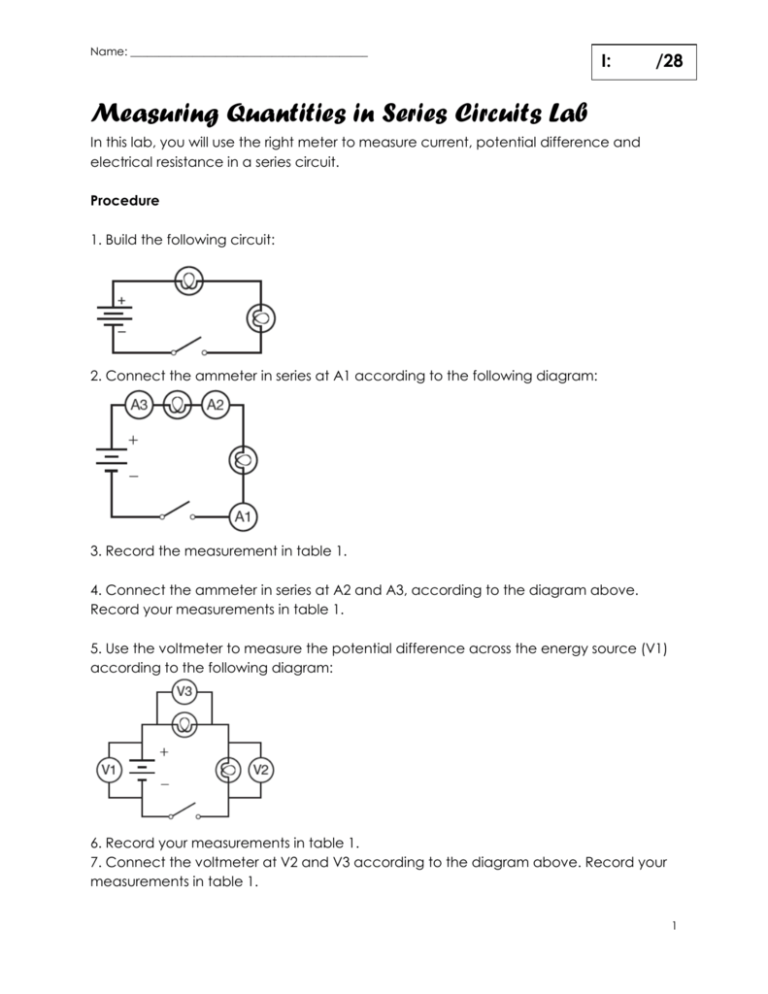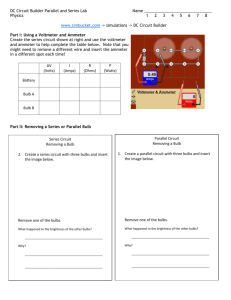Measuring Quantities in Series and Parallel Circuits Lab
advertisement

Name: __________________________________________ I: /28 Measuring Quantities in Series Circuits Lab In this lab, you will use the right meter to measure current, potential difference and electrical resistance in a series circuit. Procedure 1. Build the following circuit: 2. Connect the ammeter in series at A1 according to the following diagram: 3. Record the measurement in table 1. 4. Connect the ammeter in series at A2 and A3, according to the diagram above. Record your measurements in table 1. 5. Use the voltmeter to measure the potential difference across the energy source (V1) according to the following diagram: 6. Record your measurements in table 1. 7. Connect the voltmeter at V2 and V3 according to the diagram above. Record your measurements in table 1. 1 Name: __________________________________________ 8. Remove one of the bulbs from its socket. Note any difference in the brightness of the light. 9. Use an ammeter to measure the current at A1, A2, A3. Record your observations in table 1. 10. Use a voltmeter to measure the potential difference at V1, V2, V3. Record your observations in table 1. 11. Replace the light bulb. Use an ohmmeter to measure the total resistance of the circuit according to the diagram below: 12. Record the measurement in table 1. Table 1: Measurements of Current, Potential Difference & Resistance in a Series Circuit [8 marks] Variable 2 Bulbs in Circuit 1 Bulb in Circuit Current at A1 (A) Current at A2 (A) Current at A3 (A) Voltage at VI (V) Voltage at V2 (V) Voltage at V3 (V) Difference in brightness of other bulb Resistance (Ω) 2 Name: __________________________________________ Measuring Quantities in Parallel Circuits Lab In this lab, you will use the right meter to measure current, potential difference and electrical resistance in a parallel circuit. Procedure 1. Build the following circuit: 2. Connect the ammeter in series at A1 according to the following diagram: 3. Record the measurement in table 2. 4. Connect the ammeter in series at A2, A3 and A4 according to the diagram above. Record your measurements in table 2. 5. Use the voltmeter to measure the potential difference across the energy source (V1) according to the following diagram: 6. Record your measurements in table 2. 7. Connect the voltmeter at V2 and V3 according to the diagram above. Record your measurements in table 2. 3 Name: __________________________________________ 8. Remove one of the bulbs from its socket. Note any difference in the brightness of the light. 9. Use an ammeter to measure the current at A1, A2, A3. Record your observations in table 2. 10. Use a voltmeter to measure the potential difference at V1, V2, V3. Record your observations in table 2. 11. Replace the light bulb. Use an ohmmeter to measure the total resistance of the circuit according to the diagram below: 12. Record the measurement in table 2. Table 2: Measurements of Current, Potential Difference & Resistance in a Parallel Circuit [9 marks] Variable 2 Bulbs in Circuit 1 Bulb in Circuit Current at A1 (A) Current at A2 (A) Current at A3 (A) Current at A4 (A) Voltage at VI (V) Voltage at V2 (V) Voltage at V3 (V) Difference in brightness of other bulb Resistance (Ω) 4 Name: __________________________________________ Analysis Questions 1. Compare how you had to connect the different kinds of meters. What was the same? What was different? [2 marks] 2. How does unscrewing a bulb in the series circuit, affect the brightness of the second light bulb? [1 mark] 3. How does unscrewing a bulb in the parallel circuit, affect the brightness of the second bulb? [1 mark] 4. What conclusion can you make about electric current in a series circuit? [2 marks] 5. What conclusion can you make about electric current in a parallel circuit? [2 marks] 6. Compare the resistance in the series circuit with the parallel circuit. What did you notice? [3 marks] 5











